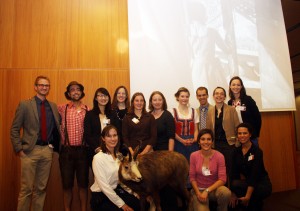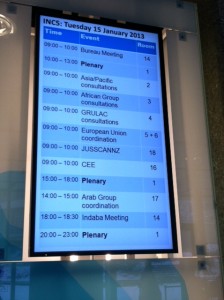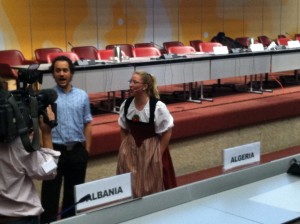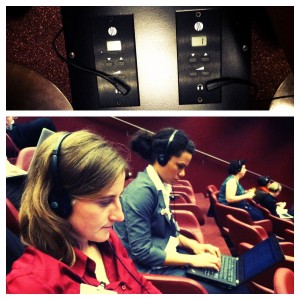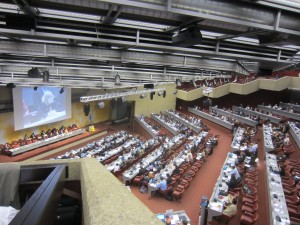by Ellen Czaika
INC5, the International Negotiating Committee on Mercury’s 5th and final meeting in Geneva, started yesterday and continues through January 18 or 19 (depending on how long it takes to reach agreement). The discussions are working off of a draft treaty text compiled by the Chair based on the INC4 talks in Uruguay last July.
Several specifics of the treaty have yet to be agreed upon. Let’s look at an overview of what is on the table this week (see our Issue Overview blogs for more details on each of these topics).
Organizational and Implementation Issues
The exact wording of the preamble has yet to be agreed upon. It sets the tone and context of the convention text. Furthermore, the implementation strength of the document is still being debated. This manifests itself partly as a debate over the use of the seemingly similar but yet importantly distinct verbs: “are able to,” “may,” and “shall.” Also relevant to the implementation strength of the treaty, the amount and type of financial and technical assistance to be associated with the agreement is far from settled.
The level of trade transparency is also in question. This issue relates to the amount of insight nations give into their mercury trade and raises questions about monitoring and data reporting.
Another discussion to be made is whether to use the words, “implementation,” “compliance,” or “implementation and compliance.” Use of the word compliance implies the creation of an oversight body that monitors nations’ mercury mining, emissions, trade, disposal, and use. “Implementation,” when used alone, leaves nations responsible for their own assessment of adherence to the treaty’s regulations.
This discussion about “implementation” and “compliance” relates to national sovereignty. Each nation wants its sovereignty respected, but in order to protect its citizens from mercury, it needs other nations to reduce emissions and releases too. If mercury did not move around the globe, a more individualized approach could make sense. However, mercury released in one area affects people worldwide.
Furthermore, the negotiating parties have yet to agree on some procedural and timeline details, such as when the treaty will enter into force (i.e., become live) and whether there will be withdrawal periods.
Additionally and importantly, the parties have yet to agree on how to discuss health aspects within the treaty. This includes whether and how to regulate dental amalgams.
Emissions and Releases Issues
One of the items the Parties will be discussing is how to reduce human-caused mercury releases. They will discuss four main topics related to releases and emissions: sources, thresholds, control objective, and flexibility.
The sources can be categorized by time (existing versus future sources), by industry (chemical production, mining, energy production, product production, waste disposal, etc.), by geography (where in the world the release happens), and by economic or other necessity, among other categories. Should we control all categories of sources? If not all, which ones will be controlled? Should we allow some exceptions for industries that provide irreplaceable employment for impoverished peoples? (If you have thoughts about this, comment below!)
To be effective, thresholds need to be precise and emissions need to be measured to ascertain whether they meet the thresholds. There is debate about whether or not to set thresholds. If thresholds are set, expect long discussions about what those numbers will be. The range of proposed limits on flue gas emissions is 0.01 to 0.2 mg/m3 (for more about this, see our Emissions and Releases Overview blog)
Discussion around the control objective includes the proposing of emission limits, setting reduction goals, relying on best available technology/practices, or wrapping mercury control in with the control of other pollutants (such as others that are released when coal is burned).
The flexibility of the agreement is also in discussion. That is, should nations be in charge of their targets and limits or should there be UN oversight of direct, global targets and limits.
Products and Processes Issues
The draft text has adopted a positive list approach, which means that only the mercury-containing products and processes listed have to be regulated (watch for my upcoming blog on the differences between positive and negative lists). However, the specific products and processes to be listed remain to be decided, as well as their phase out dates (the draft text currently contains place-holder lists). Additionally, it is not a given that both products and process will follow the same type of list; one may be negative and the other positive.
Improper disposal of mercury-containing products can lead to releases of mercury into land and water. Due to its relationship with the product list, wording around disposal is still being decided, as discussed below.
ASGM, Waste, and Trade Issues
Although the parties have agreed on some components of the treaty in regards to trade, artisanal and small-scale gold mining (ASGM), and waste, there are still several issues to be decided on these topics.
The threshold values of mercury producing facilities that must be identified and monitored within each national territory is still undecided. The higher the threshold, the fewer facilities that must bereported, and therefore potentially more mercury emissions that will be unaccounted for (but less need for monitoring resources). The lower the threshold, the more countries will have to spend on monitoring, but the more likely global mercury will be controlled.
On the issue of ASGM, the parties have not yet agreed as to whether the implementation of ASGM regulations will be contingent on the provision of financial and technical assistance.
In terms of waste monitoring, the parties have not yet decided about this convention’s relation to the Basel Convention. It is already agreed that the trade in waste will require written consent of the receiving nation. This is similar to the Basel Convention’s requirement for “prior informed consent.” However there are some parties to this mercury convention that are not parties to the Basel Convention. The INC5 negotiating parties have not decide whether nations that are not party to Basel Convention will have to comply with agreed upon transport controls, especially with respect to the informed consent and the take-back obligations of the Basel convention.
Technical Transfer and Funding Issues
Just as with any action, stopping mercury use has both desirable and undesirable consequences. Negotiating parties are trying to balance the desirable consequence (such as improved health for humans and animals) with the undesirable consequences. Some of the undesirable consequences include the loss of livelihood for those whose profession relates to mercury releases (people who work in the coal industry, miners, etc). Not reducing mercury emissions and not controlling mercury-containing products endangers the health of humans, animals, and ecosystems around the globe. Some of the people most impacted are those who work directly with mercury in conditions that lack safety precautions, such as workers in waste combustion sites and artisanal and small-scale gold miners. Finding other work for these often-impoverished workers is not as straightforward as its sounds. These workers are in a tough spot; they need work to be able to afford food and shelter, but their means of housing and feeding themselves and their families endangers their health.
Therefore, the negotiating parties will discuss means to facilitate developing nations’ creation of alternative employment and utilization of technology to reduce mercury emissions. Building this capacity in developing nations requires resources. One contentious part of this convention is who provides these resources to the developing nations and in what form.
When specifically discussing technology for reducing mercury emissions, the parties are considering technical assistance and the transfer of technology and knowledge (see our Issue Overview blog on technical and financial assistance for more about this).
Technical assistance and the transfer of technology and knowledge have the potential to create jobs related to the control of mercury, which might be able to replace the jobs that contribute to its emission. However, these types of jobs potentially require different skills and training, which is a non-trivial consideration.
This balancing of cost of implementation requires a mechanism such as a fund. The parties have agreed that there should be a fund. However, they haven’t agreed on who will contribute to it and who will manage it. Related to the management question is the frequency of reviews and evaluations of the fund. A major question on this front is whether the fund should be administered by the Global Environment Facility (GEF).
Presently, there are two options on the table for technology transfer. The first is that developed nations will create a mechanism for the transfer of technology to the least developed countries and small island developing states. The second is that the treaty will explicitly state what technology should be transferred.
The assistance issue relates very strongly to the viability of the agreement. If the means for implementing regulations aren’t available, the treaty becomes only words—and many parties probably won’t sign it. Hence, the discussion around assistance will likely be a very interesting part of the coming week!
Watch our blog and follow us on twitter @MITMercury. We’ll be posting details on the discussions and negotiations about these undecided issues as they emerge!

